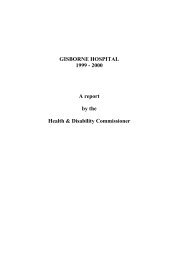09HDC01565 - Health and Disability Commissioner
09HDC01565 - Health and Disability Commissioner
09HDC01565 - Health and Disability Commissioner
You also want an ePaper? Increase the reach of your titles
YUMPU automatically turns print PDFs into web optimized ePapers that Google loves.
Opinion <strong>09HDC01565</strong><br />
The on-coming nurse did not ―go see‖ each patient immediately after report.<br />
The issue of curtains around patients <strong>and</strong> the future use of more extensive monitoring<br />
have been addressed by the CDHB. However I will comment about this further in my<br />
report as it is significant in this case.<br />
It appears that neuro observations including blood pressure, heart rate <strong>and</strong> temperature<br />
were taken regularly. However the respiratory rate was not documented as taken.<br />
Although sedation scores <strong>and</strong> the Glasgow Coma Scale were documented regularly,<br />
this does not absolve the nurse from deliberately counting respirations. Although the<br />
nurse states she heard [Mr A] snore at a regular rate, this does not tell us if the<br />
respiratory rate was trending up or down which is how clinical judgment <strong>and</strong> decision<br />
making is formulated. Respiratory rate (RR) is a sensitive <strong>and</strong> early predictor of<br />
deterioration. RR is an expected parameter to measure <strong>and</strong> document on the following<br />
CDHB forms: Early Warning Score; the adult Patient Controlled Analgesia (PCA)<br />
Treatment Sheet & Record; the Neurological Observation Chart (QMRO 100); the<br />
Drug Treatment Sheet for PRN drugs; <strong>and</strong> Neuroscience Documentation of Care. In<br />
this case the nurses did not meet the expected st<strong>and</strong>ard of care (e.g. respiratory rate) as<br />
required by the CDHB. The nurse has also failed to meet NZNO st<strong>and</strong>ards (1.10 &<br />
1.11) which state the nurse provides documentation that meets legal requirements, is<br />
consistent, effective, timely, accurate <strong>and</strong> appropriate; <strong>and</strong> uses competent clinical<br />
judgment to implement all aspects of the nursing process, ensuring appropriate care.<br />
In this case the nurse failed to assess the respiratory rate on [Mr A].<br />
As well, the nurse did not meet NCNZ Code of Conduct (principle 2; criteria 2.4, 2.5,<br />
2.9) which state the nurse demonstrates expected competencies in the practice area in<br />
which currently engaged, upholds established st<strong>and</strong>ards of professional nursing<br />
practice, <strong>and</strong> accurately maintains required records related to nursing practice. And<br />
finally NCNZ Competencies (2.2, 2.3) for registered nurses state the nurse uses<br />
suitable assessment tools <strong>and</strong> methods to assist the collection of data <strong>and</strong> maintains<br />
clear, concise, timely, accurate <strong>and</strong> current client records within a legal <strong>and</strong> ethical<br />
framework.<br />
Clinicians know that RR is a strong predictor of potentially serious clinical events.<br />
However even though the measurement of the RR requires no complex technology,<br />
RR is the most difficult vital sign to obtain. ―Normal breathing is quiet <strong>and</strong> easy —<br />
barely audible near the open mouth as a faint whish. When a healthy person lies<br />
supine, the breathing movements of the thorax are relatively slight.‖ (Bickley, 2007).<br />
Unlike blood pressure, pulse <strong>and</strong> temperature, to get an accurate RR one must closely<br />
look for a place on the patient where breathing can be detected then count for at least<br />
30 seconds to ensure an adequate count is made to determine irregularities in<br />
breathing pattern <strong>and</strong> rate (Pirret, 2005). In the dark this is even more difficult. RR<br />
monitoring takes deliberate attention <strong>and</strong> patience on the part of the clinician. It has<br />
been noted to be the most neglected vital sign (Cretikos et al, 2008).<br />
Although RR was not documented (<strong>and</strong> presumed not taken) falls short of the<br />
expected st<strong>and</strong>ards, as noted above, the evidence provided forms a picture of a patient<br />
being ―seen‖ every 2 hours (until 0500 hours) for a set of neuro observations. As well<br />
57 5 September 2012<br />
Names have been removed (except Canterbury DHB <strong>and</strong> the experts who advised on this case) to<br />
protect privacy. Identifying letters are assigned in alphabetical order <strong>and</strong> bear no relationship to the<br />
person’s actual name.
















